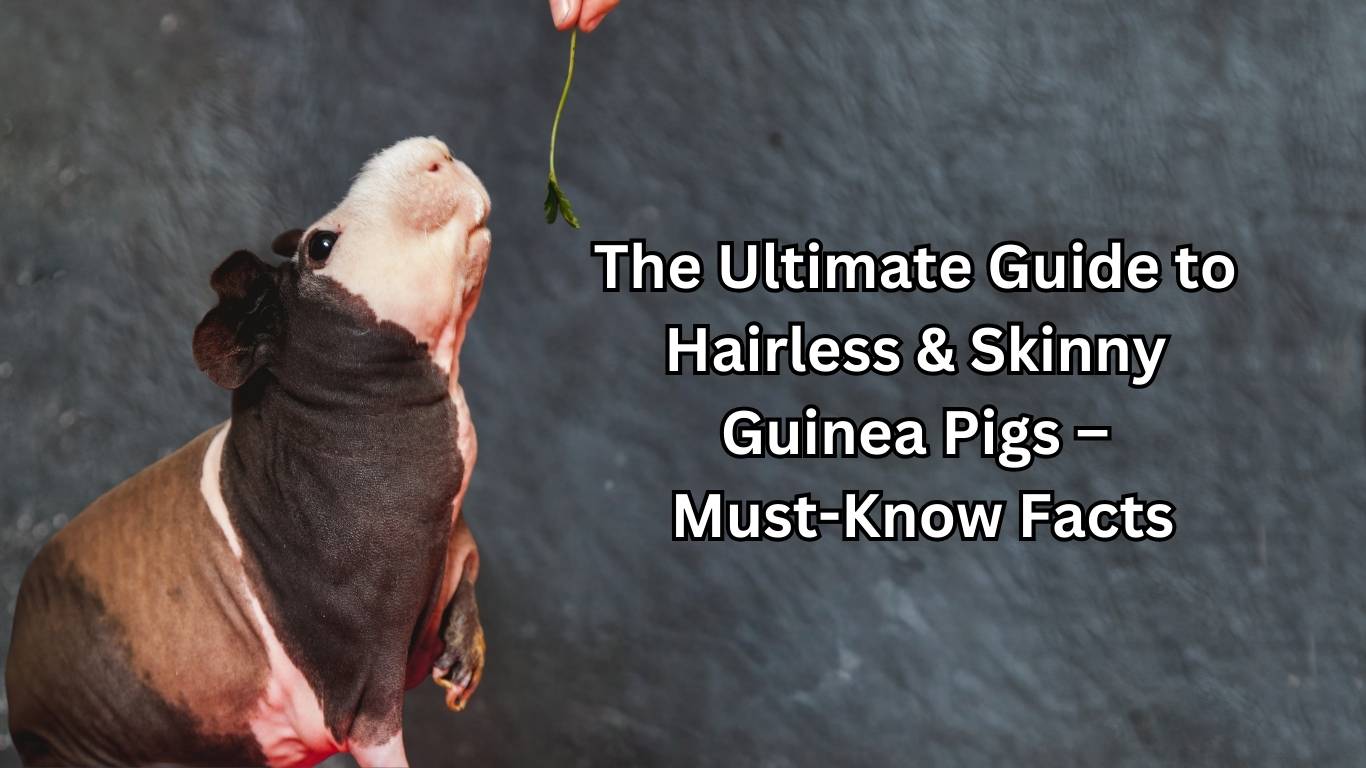The Ultimate Guide to Hairless & Skinny Guinea Pigs
Hairless guinea pigs, such as Skinny Pigs and Baldwins, require extra care due to their lack of fur, making warmth, diet, and skin protection crucial. They need a warm indoor environment, high-fiber food, and constant hydration to maintain their metabolism and prevent health issues. Their social and affectionate nature makes them fantastic companions, but their sensitive skin demands regular checks to avoid dryness, cuts, or sunburn. If you’re considering a hairless guinea pig, be prepared for specialized care, but in return, you’ll get a unique, loving pet!
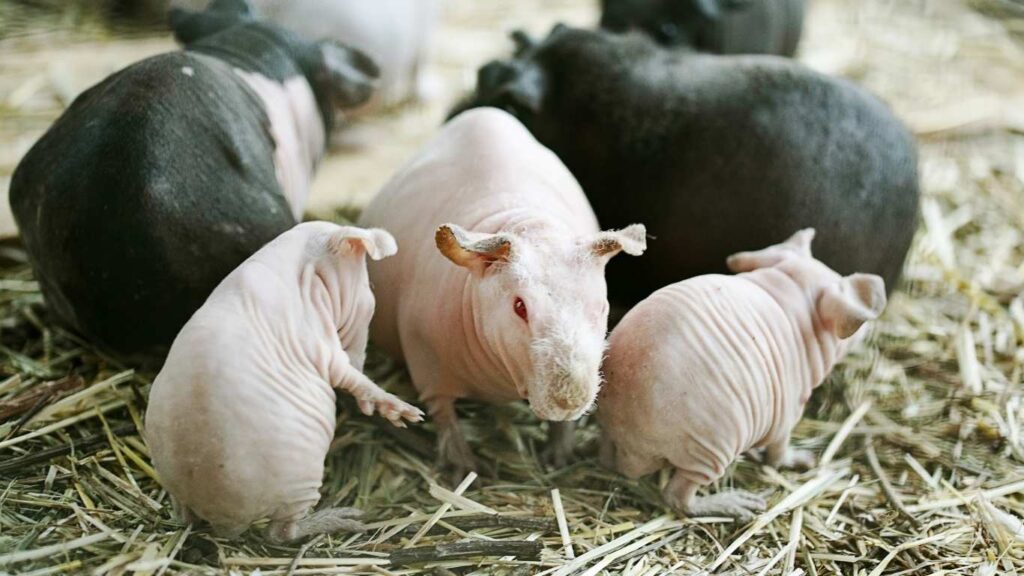
Hairless & Skinny Guinea Pigs: A Unique Twist on a Classic Pet
If you’ve ever admired guinea pigs for their pouty lips, adorable noses, and floofy fur with wool curls, rosettes, and locks, you might be surprised to learn that some guinea pigs lack this fluffy charm entirely. Enter the world of hairless guinea pigs—a truly unusual appearance that has captured the hearts of many pet lovers. Whether you are an aspiring parent considering one or simply curious, this ultimate guide will take you through everything you need to know.
These furless friends have a charm of their own. Their wrinkles along the neck and lower limbs add to their unique look, and they come in a variety of colors and patterns. There are two recognized types: the Skinny Pig and the Baldwin Guinea Pig. While Skinny Pigs retain a bit of hair, Baldwins are completely hairless as they mature. However, neither of these breeds is officially recognized by the American Cavy Breeders Association among the 13 guinea pig breeds currently accepted.
Interesting Facts About Hairless Guinea Pigs
Hairless guinea pigs, also called Skinny pigs, are similar to their furry relatives but require extra care. A fully grown adult can weigh between 1-2 lbs and grow up to 12 inches long. Their lifespan ranges from 5-7 years in domestic settings with proper care. Despite their name, they have some hair on their muzzle, back, and legs, but not enough to regulate internal temperature. They need warm environments between 65°F – 75°F and must be shielded from direct sunlight to prevent sunburn.
Appearance & Varieties
The Skinny Pig is a unique guinea pig with a mostly bald body, though it has short, stout legs and long whiskers to help feel its surroundings. Unlike regular guinea pigs, it has only bits of fur on its muzzle, feet, and back, while some are entirely bald with just peach fuzz on certain parts of their bodies.
Their bald skin makes them susceptible to sun damage and unable to regulate temperature well, leading to dry skin and a higher risk of contracting mites. They are available in different colors and patterns, including brindle, Himalayan, Dutch, chocolate, cinnamon, silver, lilac, white, and golden. Despite their unique lifestyle and care needs, these adorable, fun critters are like tiny werewolves, making them an awesome pet choice for the right owner.
Origins and Breed Types
Where do Skinny Pigs Come From? The Fascinating Story of Hairless Guinea Pigs
The origin of hairless guinea pigs is both fascinating and sad. While guinea pigs have a natural start in native Peru and were domesticated as early as 5000 BC, their hairlessness did not originate from nature. Instead, they were first discovered in a Canadian lab in 1978, when a spontaneous genetic mutation resulted in a floofless friend. Scientists in Montreal began a breeding program to study this mutation, leading to the creation of a colony for scientific purposes. These guinea pigs were originally used for dermatological studies and to test skin products, as their skin structure and composition closely resemble human skin.
For over 40 years, these piggies have been at the center of research and testing in labs. Initially, the first generations of these guinea pigs were prone to illnesses and immune problems, but four decades of careful breeding have made them heartier and healthier. Their lack of fur made them ideal for dermatological research, especially for cosmetics brands developing cruelty-free products. These brands used them to test items like face creams before placing a sticker on products claiming they were tested against animal cruelty.
The Skinny Pig breed came from an unplanned genetic mutation in the early 1980s and was later bred specifically for its unique appearance and gentle temperament. Unlike other breeds, such as white-crested cavies or Californian guinea pigs, these guinea pigs have an unusual appearance and gentle temperament. The Baldwin guinea pig is another breed, but it is different because it is born with hair that gradually falls out over two months, leaving it entirely bald. Meanwhile, Skinny Guinea Pigs are born with less hair, mainly staying on their nose and feet.
Due to their surging popularity, many people now consider them beloved pets around the globe. However, those who want to adopt should be well-prepared for their specific care requirements. It is always better to adopt from a local shelter or a reputable breeder rather than from pet stores or backyard breeders, who often ignore animal welfare. With the right attention, these outgoing and social piggies make wonderful companions for the right piggy parents.
How Many Types Of Hairless Guinea Pig Breeds
Many people are surprised to find that hairless guinea pigs are divided into two breeds—Skinny Pigs and Baldwins. The main differences between them lie in their fur covering and how their skin develops. Skinny Pigs have a lack of typical fur, except for some hair on their nose and feet, while Baldwins are born with fur that gradually falls out, leaving them with smooth, soft skin.
If you ever find yourself asking the question, “What is the difference between these types of guinea pigs?” the answer lies in their genetic traits. Skinny Pigs have been selectively bred for their lack of fur, while Baldwins come from a separate genetic mutation.
Their color and texture can vary, from pinkish tones to dark gray, with some having wrinkles and folds around the neck area. Because of their unique types, they need special attention to maintain their health, making them different from regular guinea pigs. Some people call them by their specific name, but others simply refer to them as hairless guinea pigs. If you ever have a question about these breeds, the answer lies in their genetic makeup and care needs.
There are two main types of hairless guinea pigs:
- Baldwin Guinea Pig
- Skinny Pig
Baldwin Guinea Pigs
Unlike their Skinny friends, Baldwin Guinea Pigs are born with a regular furry coat, but within the first week after birth, they start to lose their fur gradually. By the time they reach two months of age, they become completely hairless, except for their whiskers and a bit of fur on their feet. Their smooth bodies and lack of fur make them look entirely different from other guinea pigs, and they are often mistaken for a baby guinea pig. Their rubbery skin, big droopy ears, and wrinkles give them a comical look, making them stand apart from their floofy relatives. This new breed has been growing in popularity due to its uniqueness, attracting piggy parents who adore floofless companions.
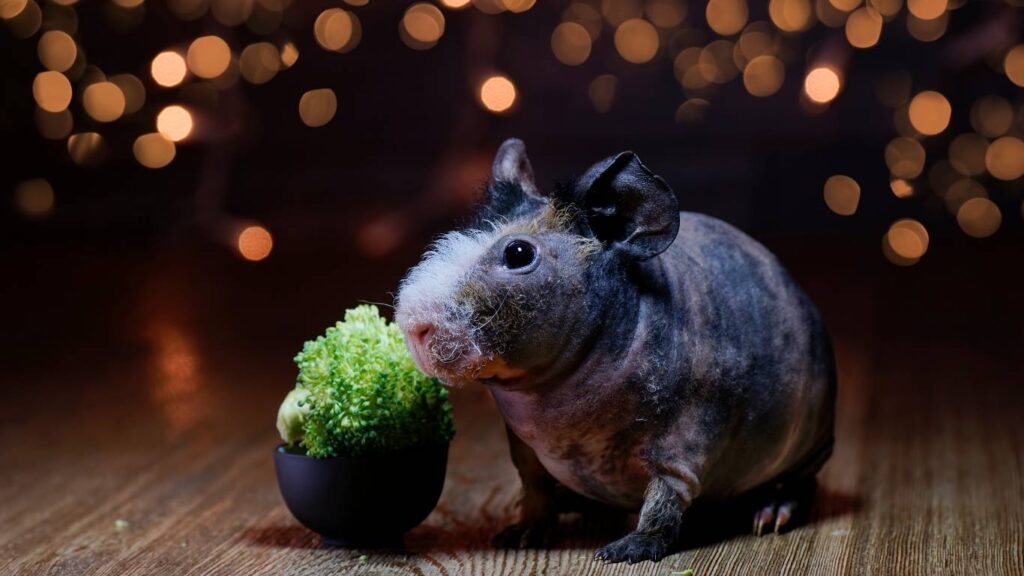
The Baldwin breed was discovered by Carol Miller, a breeder in California, who noticed that her White Crested guinea pigs were progressively losing their fur due to a spontaneous genetic mutation. This recessive gene triggers complete hair loss, leaving the guinea pig with wrinkled, rubbery skin and a hippo-like appearance. Unlike the Skinny Pig, which has some fur on its nose and feet, the Baldwin becomes entirely bald. In some cases, they develop larger, droopier ears, adding to their distinctive variation. Because of their sensitive skin, they require special care, and their piggy parents need to ensure they stay warm and comfortable throughout their lives.
Origins of Baldwin Guinea Pig Breeds
The Baldwin and hairless guinea pigs are unique because their hairlessness comes from a spontaneous genetic mutation. The first recorded case of a Baldwin guinea pig was spotted by a breeder named Carol Miller in San Diego, California. She noticed that some of her White Crested guinea pigs with golden agouti coloring started losing their fur unexpectedly
The gene responsible for this was already present in their parents, but the condition only displayed when both carriers were bred together, leading to a 25% chance of baldness in each litter. The remainder of the babies had normal fur or carried the trait without showing signs.
This recent discovery has been repeated in breeding programs, making them more popular. While their anatomy is the same as their haired variety, the exception is their faster metabolic rate, meaning they need more food to stay warm.
Characteristics of Baldwin Guinea Pig
Unlike traditional guinea pigs, which are born with full fur coats, hairless guinea pigs start with some hair but shed it within two to five days due to a recessive gene. By the time they reach two months old, they are nearly completely bald, with only a few whiskers and some hairs on their feet. The Baldwin guinea pig is entirely hairless, while the Skinny Pig retains small patches of fuzz. Their wrinkled skin gives them a unique appearance, and their rounded, full bodies with small, curious faces and large, droopy ears make them stand out. Wrinkles are often seen on the crown and shoulders, where a crest would usually form. Their rubbery texture feels almost human-like to the touch.
Distinctive Physical Features
- Large, droopy ears and small, curious faces
- Deep wrinkles on the crown and shoulders, where a crest would normally be
- Rubbery skin texture, which feels somewhat human-like to the touch
Hair Loss Process
- Born with fur, but shed their hair in a few days
- Baldwin guinea pigs become entirely hairless, while Skinny Pigs retain some fuzz
- Wrinkled skin adds to their unique look
Because they lack fur, these adorable pets are prone to skin issues and require special care to stay healthy. They are sensitive to temperature changes and must be protected from direct sunlight to avoid sunburn. Keeping them in an indoor environment with proper nesting bedding and additional heat sources helps them stay warm. Their ideal temperature is between 24 to 26°C (75 to 79°F). Due to their higher energy needs, they must eat more food to provide body warmth.
Temperature & Skin Protection
- Must be kept warm, away from cold drafts
- Nesting bedding and heat sources help maintain warmth
- Heat sources like fleece blankets help maintain body warmth
- Sensitive skin needs protection from direct sunlight
Dietary Essentials
- Need extra food intake to maintain warmth and energy
- Hay, fresh vegetables, and vitamin C-rich foods are crucial
- Constant hydration is necessary for skin and digestive health
Baldwin Guinea Pig Colors
Despite their hairlessness, Baldwin guinea pigs come in a variety of different colors and patterns, just like their haired relatives. When they first mutated, they were seen in the golden agouti color pattern, but over time, breeders have developed them in standard guinea pig varieties such as Self, Ticked, Dutch, and Himalayan. While their color may not be as striking due to the lack of fur, their patterns can still be identified by subtle pigmentation differences on their skin, making each one unique.
Young Baldwin Guinea Pig
A young Baldwin guinea pig is born with a full coat of hair, but within two to five days, it begins to fall from the head, slowly progressing toward the hind ends. By the age of two months, it becomes completely bald, showing its unique Baldwin-type hairlessness.
This spontaneous recessive mutation was discovered by Carol Miller, a breeder in California while working with White Crested guinea pigs. Since the recessive gene must be carried by both parents, breeding a Baldwin with other varieties does not always produce hairless babies, unless both carry the necessary progeny gene, resulting in more of this special breed.
Adult Baldwin Guinea Pig
An adult Baldwin guinea pig is completely hairless and has a rubbery texture with wrinkles and folds around its shoulders and head. Unlike its White Crested relatives, it lacks crowns or a crest, making its smooth skin stand out.
Because their skin is exposed, they are highly sensitive to direct sunlight and cannot tolerate cold temperatures, so it must be kept indoors. To stay warm, it may crawl into a small box or snuggle in bedding to maintain body heat, fulfilling its natural desire for comfort.
Skinny Guinea Pigs
The Skinny Pig is a hairless guinea pig with minimal hair on its nose, and feet, and small patches on its back. Unlike the Baldwin, which loses all of its fur, the Skinny Pig retains a thin, fuzzy covering that gives it a slender appearance. Some have wrinkled legs and necks, adding to their unique look. Their friendly demeanor and chatty nature, with constant squeaking, make them one of the most popular choices for pet lovers.
This breed originated from a genetic mutation discovered in 1978 at the Armand Frappier Institute in Montreal, Canada. Originally used for medical research in North America, these guinea pigs were later domesticated due to their resemblance to humans in dermatology studies. They were created through cross-breeding with the Hartley guinea pig, and because their hairlessness is a recessive trait, both parents must carry the gene to produce progeny with this condition.
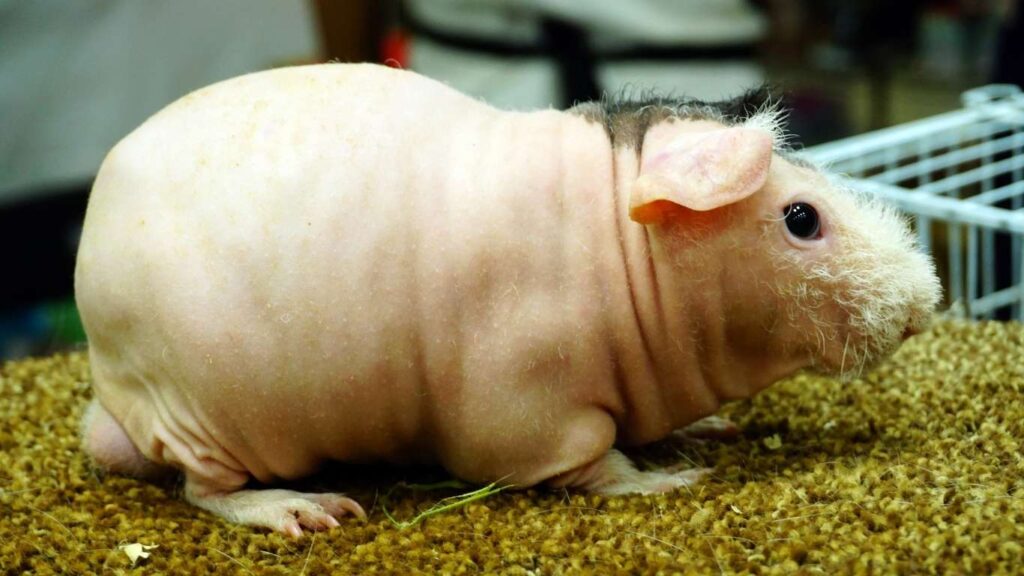
Despite their cute freckles, tufts, and fluffy legs, their skin requires special attention. They are prone to sunburn, dry skin, and injuries due to their exposed bodies. Their pigmentation varies, with black, brown, pink, and mixed patterns resembling Dutch, Tortoiseshell, and Himalayan guinea pigs. Their smooth yet thin fur can sometimes create the illusion of them looking even thinner, making them seem more delicate than their haired variety.
Because their physiology is similar to regular guinea pigs but with a higher metabolism, they need to eat more to maintain body heat. Their optimal temperature range is between 75 to 80 degrees Fahrenheit, as they cannot tolerate extreme cold. With their fuzzy bodies and werewolf-like tufts, they almost look like tiny creatures ready for a full moon howling. Despite their unusual appearance, they make wonderful pets for those willing to give them the care they need.
Origins of Skinny Guinea Pig Breeds
The history of guinea pigs becoming hairless is relatively short, with their origins tracing back to a laboratory setting. The original parents of the Skinny Pig were a normal hairy guinea pig and a hairless one, created through a genetic mutation at the Armand Frappier Institute in Montreal, Canada, in 1978. Later, in 1982, the breed was further developed at Charles River Laboratories, where they were crossbred for laboratory use. The baldness comes from a recessive gene, meaning that only when two carriers are bred together can their offspring be always hairless, while some remain fluffy carriers with normal fur.
Characteristics of Skinny Guinea Pig
Skinny pigs have smooth skin with noticeable wrinkling around their neck and legs, giving them a human-like texture when touched. Unlike their haired variety, they have short hair on their feet, bridge of their head, and nose, with thin, fuzzy patches on their backs. The Baldwin guinea pig, on the other hand, is born with hair but loses it completely over time, whereas the Skinny Pig remains partially haired. Their anatomically and physically distinct features make them a fascinating variety of hairless guinea pigs.
- Body Structure & Hair Characteristics
-
- Short hair on feet, head, and nose
- Wrinkling on the neck and legs
- Thin, fuzzy patches on the back
- Baldwin guinea pigs are born with hair but become fully bald
Due to their lack of fur, Skinny Pigs require greater energy levels and have a faster metabolic rate to maintain body warmth. They burn more fuel and need a constant supply of food and water. Their temperature control is weak, making them vulnerable to direct sunlight, burns, and climatic changes. Keeping them indoors in a regulated environment is crucial, especially in cold weather. Additionally, they are social and outgoing, forming strong bonds with their friends and owners. They are vocal, often chattering, but rarely engage in territorial disputes. These delicate pets thrive in affectionate homes where their needs are met with care.
- Health & Social Behavior
-
- Require more food and water due to a faster metabolism
- Temperature-sensitive, prone to burns and fungal infections
- Social, outgoing, and affectionate with owners
- Vocal, with minimal territorial disputes
- Need a warm and stable environment
Their entire body is hairless, much like some cats, dogs, and rats, but they come in different color varieties, including unicolor, bicolor, and tricolor. Because of their bald nature, they are particularly vulnerable in spring and summer, where probability of sunburn and catching a cold during a trip is minimal if properly cared for.
Skinny Pig Colors
The Bald Skinny Pig comes in a variety of colors and skin pigmentation similar to its haired variety. Their patterns can include Dutch, Tortoiseshell, Ticked, Roan, and Himalayan, making them as diverse as any standard guinea pig colors. While they have little hair on their face and legs, their skin still displays beautiful patterns that make each one unique.
Important Concerns for Hairless Guinea Pigs
The main concern for hairless guinea pigs is their overall well-being, as they are relatively new breeds that require more care than standard guinea pigs. Owners should be aware of their additional needs, such as staying warm, clean, and safe. Since they lack fur, they rely on extra heat to stay comfortable and need high-quality feed to support their health. Their homes must be cleaned often to prevent skin infections.
There are also concerns about fully understanding the potential consequences of promoting a recessive mutation, as it may affect the efficacy of their immune system function in the long run. Additionally, the cost of caring for them can be higher due to their unique needs.
Main Differences Between A Skinny And A Baldwin Guinea Pig
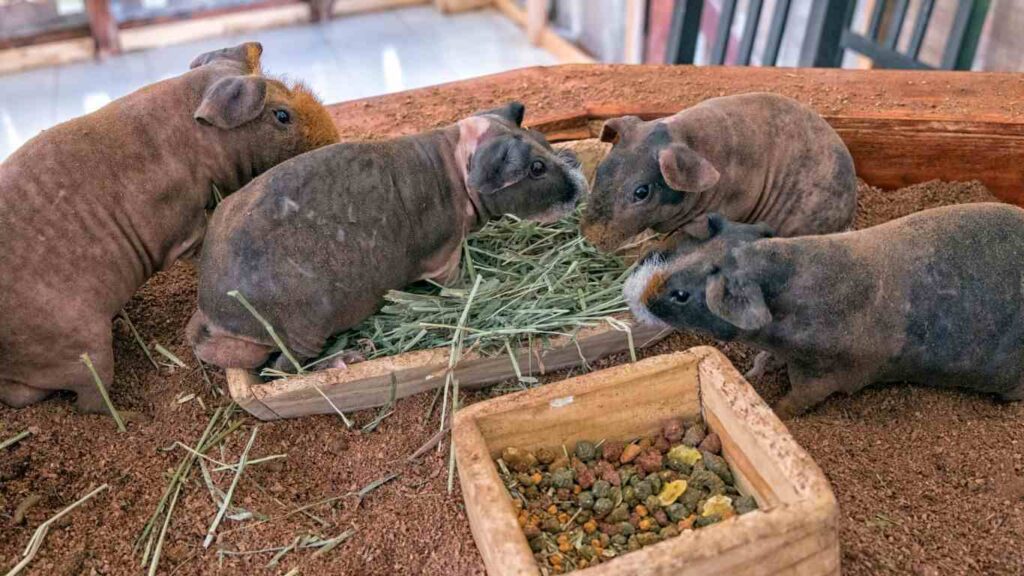
Types of Hairless Guinea Pigs
Hairless guinea pigs exist in two types: Skinny and Baldwin, and they are very different from their furry relatives. Unlike regular guinea pigs, their skin is not protected by a cozy fur coat, so they have extra needs that piggy parents must understand. Their unique appearance comes from a recessive gene responsible for their lack of fur. Skinny pigs are born hairless but keep whiskers and a little hair on their feet, face, and legs, while Baldwins are born with fur that falls out within a few days or weeks, leaving them completely bald.
Hairless Guinea Pigs are More Sensitive
Unlike regular guinea pigs, which have fur as a protective layer against cold, sun, and moisture, Skinny piggies are more sensitive to temperature and elements. Their soft skin is prone to sunburn, damage, and UV light, so they should never be exposed to direct sunlight.
In winter, they need luxury warmth to avoid freezing and must be kept away from drafts and moisture to prevent injuries and dry skin. A safe cage with soft bedding helps prevent sores and fungus, making their care more demanding. Because of these needs, their skincare routine requires experienced pig parents who understand how to keep them comfortable and healthy.
Hairless Guinea Pigs Eat More Snacks
Hairless guinea pigs have a bigger appetite because they burn more energy staying warm in the cold. Unlike their furred friends, they need extra food to keep their bodies at the right temperature. Piggy parents should always have food and water available, with plenty of fiber, vitamin C, and hay in their diet to keep them healthy. Since guinea pigs have walking stomachs, they constantly eat and poop, making their cage messy faster. The downside is that their cleaning routine is an absolute must to maintain hygiene and comfort.
Hairless Guinea Pigs Love Indoor Living
Guinea pigs without fur are best kept indoors because they are sensitive to heat, cold, and drafts. Unlike their furry relatives, Skinny pigs lack natural protection, so they should not be housed outdoors, especially in extreme weather. They need a higher room temperature between 72°F – 75°F (21°C – 24°C) to stay comfortable. Another important factor in their care is their sensitivity to the sun’s warmth—they can get sunburned easily, and using sunscreen may cause a reaction since their skin is not like human skin. If they must go outside, they should stay in shade during midday when it is hot, and piggy parents should prepare a safe setup with cool water and protection from the wind. While keeping them indoors may increase costs, it is an easy way to ensure their health and happiness.
Physical Characteristics and Temperament
Hairless Guinea Pig Temperament and Behavior
Hairless guinea pigs have delicate skin and come in different colors like black, white, brown, brindle, spotted, patterned, multicolored, tortoiseshell, Dutch, and Himalayan. Unlike their furred relatives, they have a higher temperature sensitivity, so they need a stable, warm environment to stay comfortable. Their skin is soft and slightly wrinkled, especially around the neck, and they love to be petted and picked up when they feel safe.

Because they lack fur, they enjoy snuggling in a sleep sack or against humans to stay warm in winter when it gets chilly. In terms of temperament, these guinea pigs are known to be gentle, docile, and enjoy being handled when properly socialized. Their social nature makes them bond well with their species, so they thrive when kept in pairs or groups. They are friendly, outgoing, and great for families with children.
However, when introducing new guinea pigs, they should be paired gradually to prevent confrontational or territorial issues, especially between males and females during breeding or pregnancy. They enjoy snuggling, chattering, and exploring places, but can become skittish in unfamiliar scenarios or sudden changes. Providing enrichment like feeding stations, toys, and staged introductions helps prevent stress, fighting, and injury. While they are sweet and lovable, they can bite if scared, so early bonding and desensitizing to handling are important.
Personality Traits of Hairless Guinea Pigs
Hairless guinea pigs are friendly and sociable, enjoying interacting with their owners and forming strong bonds through regular handling and attention. Due to their lack of fur, they love warmth and often seek cuddles, making them more affectionate than some other breeds. They are known for their playful behaviors and frequent vocalizations, using soft squeaks and chirps to express excitement or hunger. Their social nature makes them thrive in pairs or groups, as they enjoy companionship and constant activity.
Interaction and Socialization
A happy, healthy pet needs quality time with its owner, and a hairless guinea pig thrives on interacting daily. They require exercise, so letting them explore a supervised floor area or an outdoor play session in a secure enclosure keeps them active and engaged. When introducing compatible companions, slow socialization is key to avoiding stress. Providing enrichment like tunnels and chew toys helps them stay curious and playful.
Socialization and Compatibility
What Are Skinny Pigs Really Like?
After spending time with Skinny guinea pigs, I have learned that there is more to them than just their hairless looks. Unlike the Baldwin, which loses all its fur, Skinny pigs keep small patches of hair on their nose and feet. While their basics of care are similar to regular guinea pigs, their needs require extra attention to warmth and hygiene. Each individual has a unique personality, and once you uncover their hidden depths, you’ll see they are not just cute but also affectionate and playful.
Can Skinny Pigs Live Alone?
No, guinea pigs should not live alone, and Skinny pigs are no exception. In the wild, a guinea pig lives in herds, making them highly social animals that need a companion to thrive. If you plan to keep one, it’s best to adopt a friend, as they feel safer and happier with company. Unlike dogs or cats, they are prey animals, so they do not bond well with larger pets or other rodents. Proper pairing with another guinea pig ensures a stress-free and joyful life.
Do Skinny Pigs Like to Be Held?
A hairless guinea pig has a unique personality, and whether it enjoys cuddles depends on its comfort level and past experiences. Some can be shy at first, but with spending time and patience, they learn to enjoy the company of their hoomans. Unlike other guinea pigs, they rely more on warmth, making them more likely to snuggle with their piggy parents. Their skin is soft and fragile, so they need gentle handling. Offering a treat before picking them up helps build trust and create a bond over time.
Can Skinny Pigs Live with Hairy Guinea Pigs?
The short answer is absolutely! Hairy and hairless guinea pigs can live together in the same habitat, as long as pet parents are careful. These furry friends usually get along, but if fighting happens, they should be separated to prevent injury. Since Skinny pigs lack fur, they can get hurt quicker, so they need a cozy room temperature, an extra clean cage, and proper food to stay healthy. The golden rule is to monitor their behavior and ensure there’s no blood drawn during play.
Environmental Needs and Special Considerations
Attention in winter
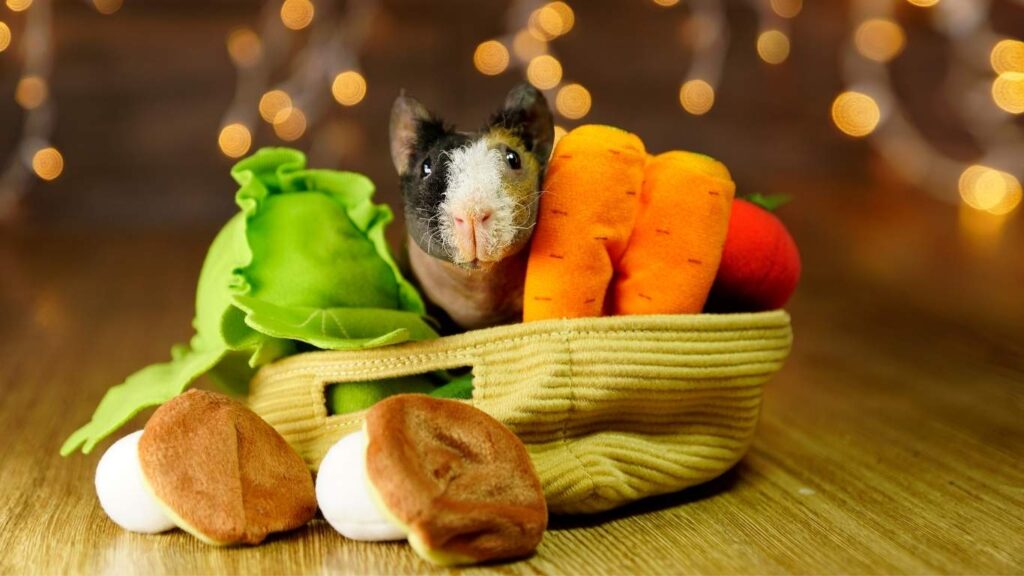
A Skinny guinea pig needs special attention in winter to stay warm and healthy. Their cage should be raised off the ground to avoid cold floors, and if possible, underfloor heating or another heat source can help maintain warmth. To prevent drafts, place the cage in a safe area, especially at night when it gets colder, as exposure can make them sick. While some direct rays of the sun can provide warmth, too much exposure can burn their skin since they lack hair for protection. Keeping them in a cozy, draft-free space ensures their comfort during the cold months.
Heat and Humidity
A Skinny pig has a completely hairless body with only small patches of fuzzy hair, making its exposed skin sensitive to heat and humidity. Because it lacks a fur coat to retain body heat, it struggles to regulate temperature and needs a warm habitat between 65-75 degrees Fahrenheit. If it gets too cold, providing a box hideaway to crawl into helps preserve warmth and avoid drafts. In higher humidity, their skin stays hydrated, helping to prevent flaking and dryness.
Proper Lighting for Hairless Guinea Pigs
A hairless guinea pig has bare skin that is sensitive and prone to damage from direct sunlight. Their habitat should be placed away from any beam of harsh light, and using sheer curtains can help diffuse the strongest rays. Unlike nocturnal animals, guinea pigs follow the natural rise and set of daylight, so they need balanced light exposure. If kept in a tank, their special needs require careful monitoring of heat and artificially controlled lighting to prevent overheating.
Temperature Needs for Skinny Pigs
Skinny pigs do not have fur to help them regulate their internal warmth, making them sensitive to temperature changes. Their cage should be kept between 65°F – 75°F to maintain a stable core temperature. Since hairless guinea pigs struggle with body regulation, they are prone to hypothermia, especially in colder months. A warm, draft-free environment is essential, so avoid placing them near vents, fireplaces, or direct sunlight to prevent overheating or chilling.
Hairless Guinea Pigs vs. Hairy Guinea Pigs
Here are five key differences to consider when comparing Hairless Guinea Pigs and Hairy Guinea Pigs.
- Hairless Guinea Pigs Eat and Drink More
- They Poop More, Too!
- They Don’t Regulate Their Body Temperatures Well
- Hairless Piggies Get Hurt Easily
- Their Skin Needs Special Care
Hairless Guinea Pigs Eat and Drink More
Hairless guinea pigs have faster metabolisms than their hairy relatives, meaning they need to eat and drink almost double the amount to stay warm. Since they lack fur, their bodies work harder to maintain heat, keeping their guts working constantly. As a result, they spend more time munching and require extra food throughout the day to stay healthy.
They Poop More, Too!
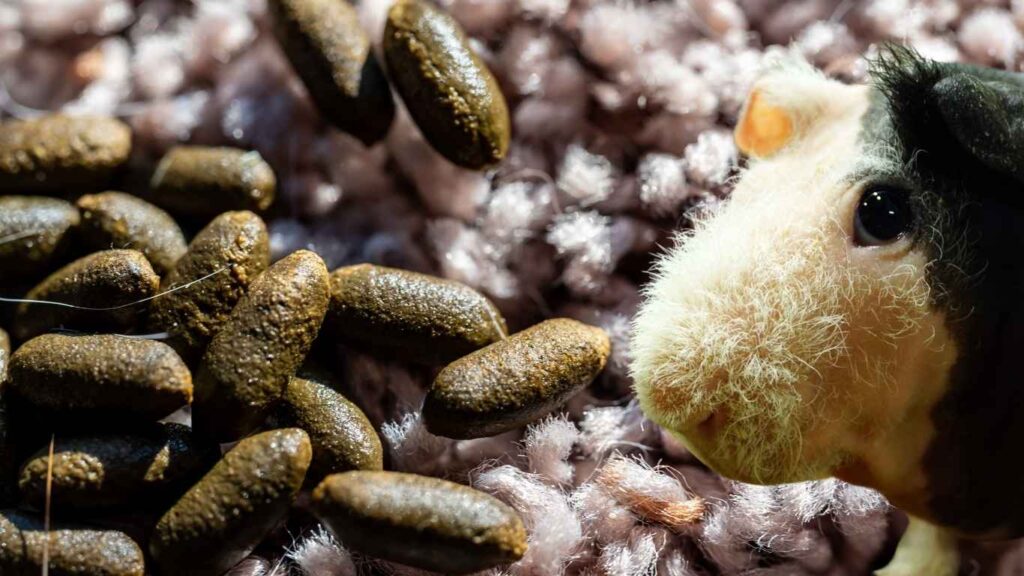
Since hairless piggies eat more, they also poop more! Their fast metabolism means that whatever goes in must come out quickly, leading to frequent pee and waste. Compared to hairy guinea pigs, they require a clean cage more often to keep their space hygienic and comfortable. Regular cleaning helps prevent odors and keeps them healthy.
They Struggle to Regulate Their Body Temperature
Unlike a normal guinea pig with fur to keep it warm in winter and cooler in summer, a hairless guinea pig cannot regulate body temperatures well. They are prone to heat stroke in hot households and need a comfortable indoor setup. Keeping them outdoors is risky, so providing fleece hides, tunnels, and a warm space prevents chills. In warm weather, avoid drafty air, and never place them directly under an air conditioner or fan, as sudden temperature changes can make them sick.
Hairless Piggies Are Delicate and Get Hurt Easily
Since hairless piggies lack fur to protect their bodies, they can hurt easily from rough surfaces or sharp objects in their cage. During bonding, they may get scratched by other guinea pigs’ nails, so keeping them short is important to avoid combat injuries. Their soft, sensitive skin is prone to issues like cuts, irritation, and sunburn, requiring extra care. Using safe fleece bedding, bath mats, or soft wood options helps prevent discomfort, while regular checkups help monitor health.
Their Skin Needs Special Care
A hairless piggy requires special care because its skin is different from a hairy guinea pig. Some have oily skin, while others experience dry problems, so regular checks are necessary. Using a cotton pad with a small amount of coconut oil helps moisturize dry areas and remove excess oils and debris. Unlike their furry counterparts, they do not need to be bathed frequently, only when needed, as over-washing can cause messy skin issues.
Conclusion
Hairless guinea pigs, like Skinny Pigs and Baldwins, bring a unique charm to the world of small pets. While they require extra care to maintain warmth, hydration, and skin health, they reward their owners with affectionate, social, and playful personalities. Their higher metabolism, sensitive skin, and unique dietary needs set them apart from their furry counterparts, making them a fascinating yet demanding pet choice. If you’re willing to provide the right environment, proper diet, and gentle care, these wrinkle-faced, lovable companions will bring endless joy and entertainment to your home! 🐹✨

